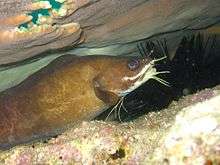Cusk-eels
The cusk-eel family, Ophidiidae, is a group of marine bony fishes in the order Ophidiiformes. The scientific name is from the Greek ophis meaning "snake", and refers to their eel-like appearance. True eels, however, diverged from other ray-finned fish during the Jurassic, while cusk-eels are part of the Percomorpha clade, along with tuna, perch, seahorses, and others. Unlike true eels of the order Anguilliformes, cusk-eels have ventral fins that are developed into a forked barbel-like organ below the mouth. In the true eels by contrast, the ventral fins are never well-developed and usually missing entirely.[1]
| Cusk-eels | |
|---|---|
 | |
| Pudgy cusk-eel (Spectrunculus grandis) | |
| Scientific classification | |
| Kingdom: | Animalia |
| Phylum: | Chordata |
| Class: | Actinopterygii |
| Order: | Ophidiiformes |
| Suborder: | Ophidioidei |
| Family: | Ophidiidae Rafinesque, 1810 |
| Subfamilies | |
|
See text | |
They are found in temperate and tropical oceans throughout the world. They live close to the sea bottom, ranging from shallow water to the hadal zone. One species, Abyssobrotula galatheae, was recorded at the bottom of the Puerto Rico trench, making it the deepest recorded fish at 8,370 m (27,460 ft).[2][3]
The largest species, Lamprogrammus shcherbachevi, grows up to 2 m (6.6 ft) in length, but most species are shorter than 1 m (3.3 ft). Unlike their close relatives, the viviparous brotulas of the family Bythitidae, they are egg-laying, and the larvae live amongst the plankton, relatively close to the surface.[2]
A few species are fished commercially, most notably the pink cusk-eel, Genypterus blacodes.
Genera
The cusk-eel family contains about 240 species, grouped into 50 genera:[4]
Subfamily Brotulinae
- Genus Brotula – typical brotulas
Subfamily Brotulotaenilinae
- Genus Brotulotaenia
Subfamily Neobythitinae
- Genus Abyssobrotula
- Genus Acanthonus – bony-eared assfish
- Genus Alcockia
- Genus Apagesoma
- Genus Barathrites
- Genus Barathrodemus
- Genus Bassogigas
- Genus Bassozetus
- Genus Bathyonus
- Genus Benthocometes
- Genus Dannevigia – Australian tusk
- Genus Dicrolene
- Genus Enchelybrotula
- Genus Epetriodus – needletooth cusk
- Genus Eretmichthys
- Genus Glyptophidium
- Genus Holcomycteronus
- Genus Homostolus – filament cusk
- Genus Hoplobrotula
- Genus Hypopleuron – whiptail cusk
- Genus Lamprogrammus
- Genus Leptobrotula
- Genus Leucicorus
- Genus Luciobrotula
- Genus Mastigopterus
- Genus Monomitopus
- Genus Neobythites
- Genus Neobythitoides
- Genus Penopus
- Genus Petrotyx
- Genus Porogadus
- Genus Pycnocraspedum
- Genus Selachophidium – Gunther's cusk-eel
- Genus Sirembo
- Genus Spectrunculus
- Genus Spottobrotula
- Genus Tauredophidium
- Genus Typhlonus
- Genus Ventichthys – East-Pacific ventbrotula
- Genus Xyelacyba
Subfamily Ophidiinae
- Genus Cherublemma – black brotula
- Genus Chilara – spotted cusk-eel
- Genus Genypterus
- Genus Lepophidium
- Genus Menziesichthys
- Genus Ophidion
- Genus Otophidium
- Genus Parophidion
- Genus Raneya – banded cusk-eel
Gallery
 Brotula multibarbata (Brotulinae)
Brotula multibarbata (Brotulinae) Bassozetus normalis (Neobythitinae)
Bassozetus normalis (Neobythitinae) Lamprogrammus niger (Neobythitinae)
Lamprogrammus niger (Neobythitinae) Monomitopus agassizii (Neobythitinae)
Monomitopus agassizii (Neobythitinae) Porogadus miles (Neobythitinae)
Porogadus miles (Neobythitinae)
 Otophidium omostigma (Ophidiinae)
Otophidium omostigma (Ophidiinae)
References
- Froese, Rainer, and Daniel Pauly, eds. (2006). "Ophidiidae" in FishBase. February 2006 version.
- Nielsen, Jørgen G. (1998). Paxton, J.R.; Eschmeyer, W.N. (eds.). Encyclopedia of Fishes. San Diego: Academic Press. p. 134. ISBN 0-12-547665-5.
- "What is the deepest-living fish?". Australian Museum. 23 December 2014. Retrieved 18 September 2015.
- Froese, Rainer, and Daniel Pauly, eds. (2008). "Ophidiidae" in FishBase. December 2008 version.
External links
| Wikimedia Commons has media related to Ophidiidae. |
| Wikispecies has information related to Cusk-eels |